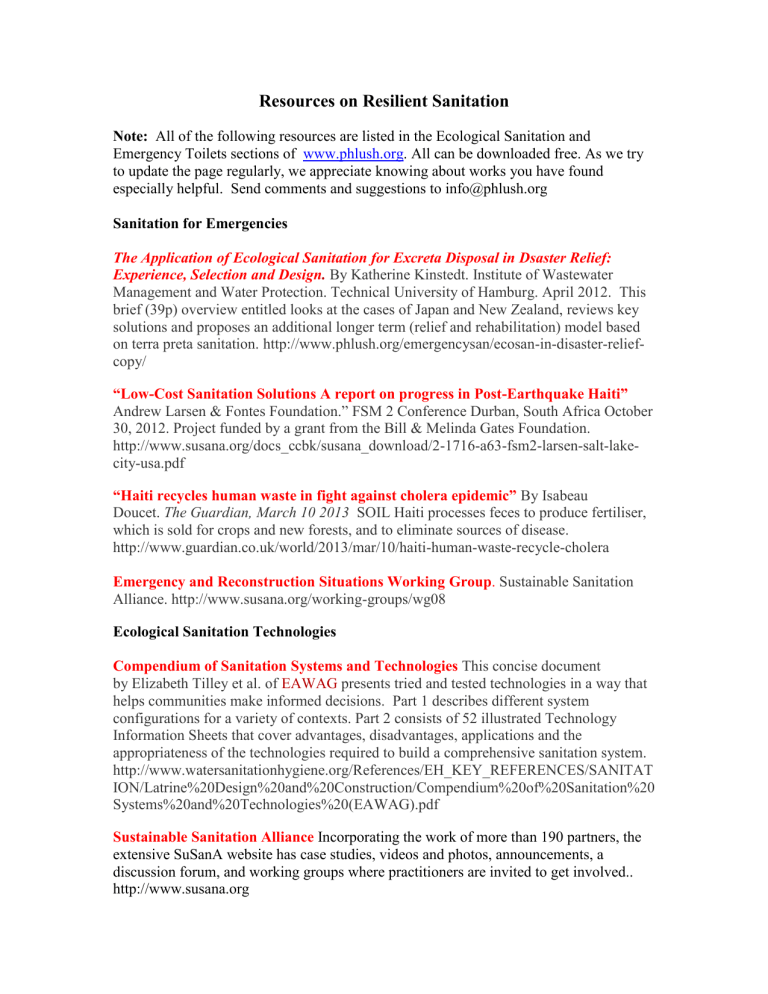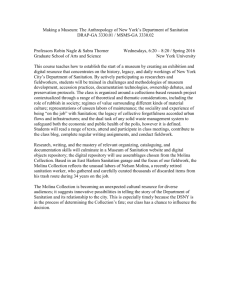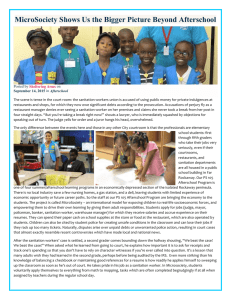Resources on Resilient Sanitation

Resources on Resilient Sanitation
Note: All of the following resources are listed in the Ecological Sanitation and
Emergency Toilets sections of www.phlush.org
. All can be downloaded free. As we try to update the page regularly, we appreciate knowing about works you have found especially helpful. Send comments and suggestions to info@phlush.org
Sanitation for Emergencies
The Application of Ecological Sanitation for Excreta Disposal in Dsaster Relief:
Experience, Selection and Design .
By Katherine Kinstedt. Institute of Wastewater
Management and Water Protection. Technical University of Hamburg. April 2012. This brief (39p) overview entitled looks at the cases of Japan and New Zealand, reviews key solutions and proposes an additional longer term (relief and rehabilitation) model based on terra preta sanitation. http://www.phlush.org/emergencysan/ecosan-in-disaster-reliefcopy/
“Low-Cost Sanitation Solutions A report on progress in Post-Earthquake Haiti”
Andrew Larsen & Fontes Foundation.” FSM 2 Conference Durban, South Africa October
30, 2012. Project funded by a grant from the Bill & Melinda Gates Foundation. http://www.susana.org/docs_ccbk/susana_download/2-1716-a63-fsm2-larsen-salt-lakecity-usa.pdf
“Haiti recycles human waste in fight against cholera epidemic”
By Isabeau
Doucet. The Guardian, March 10 2013 SOIL Haiti processes feces to produce fertiliser, which is sold for crops and new forests, and to eliminate sources of disease. http://www.guardian.co.uk/world/2013/mar/10/haiti-human-waste-recycle-cholera
Emergency and Reconstruction Situations Working Group . Sustainable Sanitation
Alliance. http://www.susana.org/working-groups/wg08
Ecological Sanitation Technologies
Compendium of Sanitation Systems and Technologies This concise document by Elizabeth Tilley et al. of EAWAG presents tried and tested technologies in a way that helps communities make informed decisions. Part 1 describes different system configurations for a variety of contexts. Part 2 consists of 52 illustrated Technology
Information Sheets that cover advantages, disadvantages, applications and the appropriateness of the technologies required to build a comprehensive sanitation system. http://www.watersanitationhygiene.org/References/EH_KEY_REFERENCES/SANITAT
ION/Latrine%20Design%20and%20Construction/Compendium%20of%20Sanitation%20
Systems%20and%20Technologies%20(EAWAG).pdf
Sustainable Sanitation Alliance Incorporating the work of more than 190 partners, the extensive SuSanA website has case studies, videos and photos, announcements, a discussion forum, and working groups where practitioners are invited to get involved.. http://www.susana.org
SSWM Toolbox The Sustainable Sanitation and Water Management Toolbox combines clarity on the fundamental concepts with a myriad of practical tools for both planning and process and for implementation. The interplay between concept and practice is embodied in the brilliant user interface. http://www.sswm.info/category/concept/conceptintroduction
Sustainable Sanitation for the 21st Century Each of the 25 modules of this free 5 or 6 week course is clearly laid out like this and combines illustrated explanatory source materials and links to further reading with a slide presentation. http://www.sustainablesanitation.info
EcoSanRes This project of the Stockholm Environment Institute offers online ecosan publications, factsheets, ecosan resources focused on the developing world, EcoSanRes hosts a discussion group for ecosan professionals. To join please send an e-mail describing your interest, name and affiliation.
http://www.ecosanres.org/index.htm
Technology Review of Urine Diversion Dehydration Toilets (UDDTs): Design
Principles, Urine and Faeces Management .
Christian Rieck, Dr. Elisabeth von
Muench. Deutsche Gesellschaft für Internationale Zusammenarbeit (GIZ). Eschborn,
May 2011. Available at: www.susana.org/langen/library?view=ccbktypeitem&type=2&id=874
The SOIL Guide to Ecological Sanitation SOIL (Sustainable Organic Integrated
Livelihoods) has worked in Haiti before and since the earthquake. Their training manual can be downloaded on line following your request. http://www.oursoil.org/soils-ecosaneducation-resources/
Sustainable Sanitation in Cities: A Framework for Action
Christoph Lüthi, Arne Panesar, Thorsten Schütze, Anna Norström, Jennifer McConville,
Jonathan Parkinson, Darren Saywell, Rahul Ingle, 2011. Superb 165 page study explains what’s wrong with contemporary urban systems and what systems that are environmentally and financially more sustainable look like. http://www.gdrc.org/uem/usan/susana_sustainable_sanitation_in_cities_2011.pdf
Earthquakes and Sewers
The Oregon Resilience Plan: Reducing Risk and Improving Recovery for the Next
Cascadia Earthquake and Tsunami.
Report to the 77th Legislative Assembly from Oregon Seismic Safety Policy Advisory Commission, February 2013
Full plan: http://www.oregon.gov/OMD/OEM/osspac/docs/Oregon_Resilience_Plan_Final.pdf
Executive Summary http://www.oregon.gov/OMD/OEM/osspac/docs/Oregon_Resilience_Plan_Executive_Su mmary_Final.pdf
The Orphan Tsunami The story of the January 26,1700 earthquake which struck the
Pacific Northwest reads like an adventure story. Authored by Brian F. Atwater in collaboration with Japanese experts, the beautifully illustrated 144-page book is downloadable free. http://pubs.usgs.gov/pp/pp1707/pp1707.pdf
Earthquake and Hazards Program of the Association of Bay Area Governments.
Information specific to water and wastewater treatment plants on liquefaction, landslides, location of active faults and details of infrastructure in hazard areas. http://quake.abag.ca.gov/water/
Seismic Assessment and Design of Sewers Webinar on earthquake hazards and their impact on wastewater collection systems by Donald Ballantyne, an engineer who has worked on systems in Vancouver BC, Seattle, Portland and SanFrancisco. http://www.asce.org/Content.aspx?id=12884903562#More
“Sewers Float and other aspects of Sewer Performance in Earthquakes” has illustrations of damaged sewer lines and wastewater treatment plans in a number of US and Japanese cities. Since water pipes must be able to withstand both pressure and soil loading, they are much stronger than sewer pipes which only need to withstand soil loading. While water plants are generally built on competent soils, wastewater treatment plans are often built on fill where there is greater risk of liquefaction.
“Calif. quake model looks for ‘big one’ in NW”
Keely Chalmers January 10, 2013
Short (2:20) video. Good for training awareness.
The Earthquake Engineering Research Institute . A place to follow the latest research. https://www.eeri.org/seismic-safety-policy-advocates/
“Billions needed to upgrade America’s leaky water infrastructure.” Washington
Post. January 2, 2012. In the United States, sewer infrastructure is already vulnerable and problems are exacerbated by customer ignorance. http://www.washingtonpost.com/local/billions-needed-to-upgrade-americas-leaky-waterinfrastructure/2011/12/22/gIQAdsE0WP_print.html
“Saving U.S. Water and Sewer Systems Would Be Costly”
By Charles Duhigg New
York Times : March 14, 2010 http://www.nytimes.com/2010/03/15/us/15water.html?pagewanted=all&_r=1&
Urine Reuse
Practical Guidance on the Use of Urine in Crop Production .
Anna Richert, Robert
Gensch, Håkan Jönsson, Thor-Axel Stenström and Linus Dagerskog. Stockholm
Environment Institute, EcoSanRes Series, 2010-1. Available at: www.ecosanres.org/pdf_files/ESR2010-1-
PracticalGuidanceOnTheUseOfUrineInCropProduction.pdf






